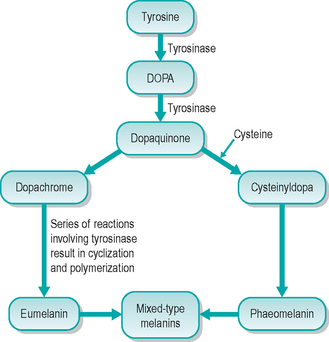39 Introduction to skin and hair pigmentation
Skin and hair colour is genetically determined and is mainly due to the presence of melanin pigment. Melanin is produced by melanocytes, cells present in the epidermis and hair follicles, in a highly organized multiple-step process. Within melanocytes, melanin is synthesized in intracellular cell organelles called melanosomes.
The melanosome is the principal product of melanocytes and is a highly organized, membrane-bound organelle within which melanin synthesis takes place. The initial steps (Fig. 39.1) of melanin synthesis are under the control of the enzyme tyrosinase, which oxidizes tyrosine to DOPA and then to dopaquinone. This undergoes a series of further complex reactions, involving cyclization and oxidative polymerization, to form the different types of melanins. The process of melanin transfer to surrounding keratinocytes involves transport of melanosomes to the tips of the dendrites and then subsequent transfer across to keratinocytes (Fig. 39.2). The transfer of melanosomes to neighbouring cells occurs by a combination of phagocytosis and diffusion through cell membranes, and is known as cytocrinia. As keratinocytes ascend through the epidermis and undergo differentiation, transferred melanins are released from melanosomes by lysosomal acid hydrolases. The visible skin colour depends on the stage of melanosome transfer, the size of the melanosomes and on how widely they are dispersed.
Stay updated, free articles. Join our Telegram channel

Full access? Get Clinical Tree



